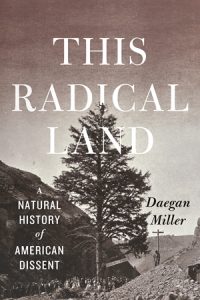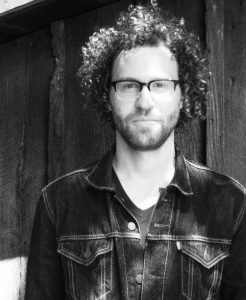7 questions for Daegan Miller about This Radical Land: A Natural History of American Dissent


Daegan Miller’s new book This Radical Land has been receiving strong praise for its unearthing of forgotten nineteenth-century stories of American dissent and environmental awareness. Kirkus Reviews wrote:
A debut book that ranges across disciplines and decades to connect the natural environment–especially long-lived trees–to a scathing critique of American-style capitalism. Alternating abstract theory with impressive research, both bolstered by extensive sources . . . the author builds his case about understanding American history by examining destruction of the environment through essays grounded in the 19th century. . . . He offers an eclectic education often marked by soaring prose.
A reviewer for Pacific Standard, meanwhile, praised Miller’s “interpretive brilliance and gorgeously crafted prose” and called the book “one of the most elegant and insightful examples of environmental writing I’ve seen in many, many years.”
We asked Daegan to take time out from his daily routine of work, reading, writing, running, and raising a family to answer a few questions about the book and the stories it tells.
This Radical Land maps a number of little-known stories of nineteenth-century America. Which one—if any of these—set you off on the project of the book? And how did you come across it?
Ah, the “process” question. I have great faith in the essay, not just as a genre, but as a method, as a way of inhabiting the world. To essay means “to try,” and the form is as much about exploration as it is exposition. This is all to say that there was no real project until there was a book, and vice versa. What I had instead were inklings. I knew that I wanted to write a book that focused on landscape and alternative, anticapitalist culture. But aside from that, I had nothing but inklings. Learning that Thoreau was a land surveyor was the first inkling. Then I discovered a photograph by AJ Russell (the photograph on the cover of my book) which led me to the west, the transcontinental railroad, and landscape photography. Then, I think, I inkled my way to the sequoias, though I had no idea what I was going to do with them until I kept stumbling across reference to a socialist commune during an early research trip to the Huntington Library. The final inkling took me to the Adirondacks. So, if you’re keeping track, I wrote the book in a wacky order: I started in the beginning, with Act 1, then jumped to Act 3, then Act 4, then Act 2. My method was to essay–to open myself to hunches, inklings, sneaking suspicions, and then follow them, wherever they took me.
You argue powerfully, with the help of these nineteenth-century examples, for a new conception of wilderness, one that acknowledges the place of the human. Is there a way for us to enact that in our everyday lives?
I get this question a lot, and I approach the answer as someone who was trained to be a cultural and intellectual historian–that is, someone who works primarily with ideas. The great faith at the root of my book (as well as pretty much everything I do) is that thought underlies action, that action is thought made manifest, that it’s important to be deliberate in our thinking. So, the way I interpret your question is: how to bring thoughtfulness about wilderness into our everyday lives? Perhaps one way is to return to essaying, to be curious, to ask when you’re out in “wilderness” areas, what is the human history of this place. Or to ask, of any place that you are, “could this be a wilderness?” You might not know the answer–that’s ok. In fact, that’s preferable, I think–the unknown. There’s a great danger to concrete, stable definitions, because they foreclose the space of unknowing, the space of wonder and possibility. That’s fairly abstract, I realize, so how about this: I argue in the book that wildernesses are spaces that nurture wildness, and that wildness is, essentially, the ungovernable, autonomous spirit of all life, human as well as nonhuman. How can you build wildness into your daily life? Can you let a corner of your yard go? What about maintaining it not as a golf course, but a mini bird-and-butterfly sanctuary? What about exploring the urban wild, the little pockets of green that crop up in forgotten urban places? Or welcoming the wild inside–cohabitating with spiders and mice? I have friends who scatter wildflower seeds in urban intersections, parking lot islands, those drab planters outside of shopping centers; I always loved that idea. How about some wildness at work (though this is sure to negatively affect the bottom line)? None of this is the same as living deliberately in the woods, as do the characters that I write about in my wilderness chapter, but I like the idea of finding ways, not just to get a living, but to actually live.
John Brown makes an appearance in This Radical Land, as a side note to the story of a settlement of free African Americans and escaped slaves in the Adirondacks that flourished for a time in the 1850s. When Brown came to the settlement to recruit for his war on slavery, the residents basically said, no, thanks, we’ve got our own thing here. Is Brown a figure you feel comfortable assessing? I will confess: when I think about Brown, and about how abolitionists I deeply admire lauded him, I struggle. Is my horror at his violence wholly a product of my distance in time? What did those people see—or not see—that made them feel different?
Brown was horrifying in his own time, in the South, obviously, but throughout the North, as well. Even members of the “Secret Six” who had foreknowledge of the Harper’s Ferry raid were shocked when he carried it out. Whether you approve of his actions or not, the fact is that he was an extraordinarily violent person, an old-school patriarch, whether it was tallying up each of his children’s minuscule faults in a ledger and then beating them bloody until they had paid down their “debt,” or supervising the slaying of proslavery settlers in the Kansas territory. He quite literally thought he was God’s avenging angel–that sort of confidence should make anyone uncomfortable. As one of his recent biographers acknowledged, Brown was a terrorist, and the deeply uncomfortable question Brown asks us is whether or not revolutionary terrorism is ever legitimate. Brown asked of his time (and of ours) this question: what do you do when the house of legitimate government stops functioning? One answer to that question, the revolutionary answer, has always been, burn it down.
Perhaps the most surprising story in This Radical Land is that of Kaweah, the explicitly Marxist commune founded in the shadow of the redwoods in the 1880s. It held strong for several years, but it was eventually pushed out by a combination of railroad interests and preservationists who held a different view of the value of wilderness. It’s a type of fate not uncommon for communes. Could you imagine a different one for this group? Could you see a Kaweah that made it into the twentieth century, and had to grapple with the rise of the very different communal society of the Soviet Union?
Yes! You can easily imagine a Kaweah that lasted ten more years (until 1900), that caught the radical winds blowing from Europe in the teens and twenties, that found itself veering towards Leninism, and then Stalinism. There was a strong corporatist element at work among some of the Kaweahans, and it’s not hard to see them verging towards an authoritarian Leftism. Or maybe Trotsky might have taken refuge in California–what would have happened then? Conversely, perhaps Kaweah would have moderated and fallen in with the capital-friendly New Deal liberalism and become an extended CCC in the sequoias. But I think the alternate past I like to imagine is that Emma Goldman emigrated to Kaweah in the early 1900s, bringing her anarchist magazine, Mother Earth with her. I like to imagine that, under her influence, Kaweah would grow into a green feminist utopia, that it would have lived into the twentieth century as an example of radical green liberation, very different from the standard narrative of environmentalism.
You open the book with the concept of a witness tree, a tree that would be marked by surveyors to show the boundaries of a property, but which can be seen to stand in some ways as a marker of the extension of a place, and human relationship to that place, through time. Witness trees themselves are long gone as an active tool. But is there anything in your town that you can see playing a similar role today?
The place where I live, now, Madison, Wisconsin, is a place of lakes, and the lakes have fired the imagination of the humans who have been living near their shores for thousands of years. Ever since my family and I moved to Madison a few years ago, I’ve been running around the lakes, and they’re a palimpsest of landscape history. There are mounds, erected around 1,000 years ago by groups of Woodland American Indians, defunct factories, railroad beds and yards. Madison’s wealthiest have their lakefront homes, and the public shores draw a varied cross-section of Madison’s fishermen, some fishing for sport, some for sustenance. Like witness trees, the lakes here have, it seems, always helped the humans who live near their shores make sense of their place in the world. And just like witness trees, the lakes tell many different stories–of imperialism and dispossession, of recreation and environmental degradation, of wealth and the struggle to make ends meet.
If we’ve read This Radical Land and feel inspired, what should we read next?
Ooof, the hardest question! There’s so much beauty out there, so many poems, essays, novels, even monographs that ask their readers to dwell for awhile with something outside of the individual self. Here are three things that I read in the very final stages of revising that I could recommend to everyone: Ralph Ellison’s Invisible Man, Sarah Sentilles’s Draw Your Weapons, and Eliot Weinberger’s An Elemental Thing. The connections to my book are tenuous: a novel focused on mid-nineteenth century African American life; an extraordinary book-length essay on photography, violence, and possibility; a short essay collection on beauty and the landscape–but then, I think part of what I’d like my book to do is to strengthen tenuous strands. Each of the books I name is, ultimately, a meditation on how to live in the world with others, which isn’t far at all from the subjects I chronicle in the book.
Who would you rather have dinner with, Thoreau or Emerson?
Well, Emerson would undoubtedly set the better table, but I don’t think I’m patrician enough to make it in his crowd. I’d love to say Thoreau, but I swear too much (Thoreau hated foul language) and he’d be offended at the bottle of bourbon I’d bring (it probably wouldn’t go well with the raw woodchuck and moldy crabapples he’d no doubt offer). So I’m going to go with Edward Abbey.
To learn more about This Radical Land or buy a copy, you can visit the book’s page on our site. (Author photo by Talia Miller.)